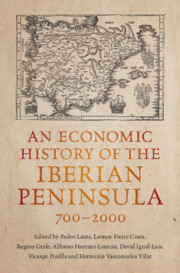Book contents
- An Economic History of the Iberian Peninsula, 700–2000
- An Economic History of the Iberian Peninsula, 700–2000
- Copyright page
- Contents
- Figures
- Tables
- Contributors
- Preface: By Way of Presentation
- Introduction
- Part I The Making of Iberia, 700–1500
- Section I The Early Middle Ages, 700–1200
- Section II The Medieval Economy, 1000–1500
- 2 Production, 1000–1500
- 3 Population, 1000–1500
- 4 The Polity, 1000–1500
- 5 Money, Credit and Banking, 1000–1500
- 6 Technology, 1000–1500
- 7 Living Standards, 1000–1500
- 8 International Trade and Commerce, 1000–1500
- 9 The Iberian Economy in Global Perspective, 700–1500
- Part II Globalization and Enlightenment, 1500–1800
- Part III Industrialization and Catching Up, 1800–2000
- References
- Index
8 - International Trade and Commerce, 1000–1500
from Section II - The Medieval Economy, 1000–1500
Published online by Cambridge University Press: 22 February 2024
- An Economic History of the Iberian Peninsula, 700–2000
- An Economic History of the Iberian Peninsula, 700–2000
- Copyright page
- Contents
- Figures
- Tables
- Contributors
- Preface: By Way of Presentation
- Introduction
- Part I The Making of Iberia, 700–1500
- Section I The Early Middle Ages, 700–1200
- Section II The Medieval Economy, 1000–1500
- 2 Production, 1000–1500
- 3 Population, 1000–1500
- 4 The Polity, 1000–1500
- 5 Money, Credit and Banking, 1000–1500
- 6 Technology, 1000–1500
- 7 Living Standards, 1000–1500
- 8 International Trade and Commerce, 1000–1500
- 9 The Iberian Economy in Global Perspective, 700–1500
- Part II Globalization and Enlightenment, 1500–1800
- Part III Industrialization and Catching Up, 1800–2000
- References
- Index
Summary
This chapter analyses foreign trade and trade routes in the Iberian Peninsula between the eleventh and the fifteenth centuries. It overviews the dual circumstances of the Christian kingdoms and of the Muslim al-Andalus over the long term, although it focuses especially on the period between the thirteenth and the fifteenth centuries, and on events taking place in Castile, Aragon and Portugal. The study tries to answer questions like how were the Iberian trade ties forged, how did the Iberian economies integrate with the Mediterranean and north-European markets, and what role did Iberian and foreign traders play in the commercial gamble. For this purpose, the Iberian trade is examined from three different angles. First, from the routes and the goods traded among the Iberian kingdoms as well as outside Iberia. Second, from the role of agents and institutions. This will involve an analysis of the distinction between local and foreign traders, as well as the influence of institutional frameworks on foreign trade. Finally, the chapter clarifies the reasons why Iberia achieved a leading position in European trade during the later middle ages, and why it spearheaded foreign trade at the dawn of the sixteenth century and the so-called “First Global Age”.
Keywords
- Type
- Chapter
- Information
- An Economic History of the Iberian Peninsula, 700–2000 , pp. 199 - 220Publisher: Cambridge University PressPrint publication year: 2024



